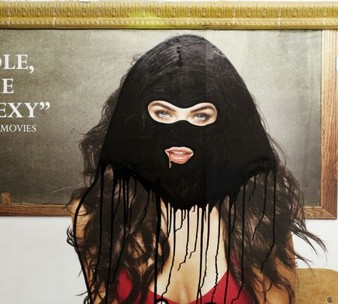 Princess Hijab was here. Just after dawn, when the Paris metro starts running, beware! A looming, long-haired figure skulks around train stations hunting prey. Her targets: consumer advertising. Her weapon of choice: a fat black paint marker. Her method: Hijabisation. Paris' latest street art sensation Princess Hijab stalks the scantily clad women and men on the posters adorning subway platforms and gives them a costume change. In quick, broad strokes, she covers them with a niqab, dripping in wet, black ink. From Dolce & Gabbana to H&M, she leaves a veil trail of topical ad-busting. With the hijab prohibited in schools and the burqa and niqab to be banned from public spaces starting in 2011, Princess Hijab's guerilla art seems like a strike of retaliation. Yet she claims in a recent exclusive interview with The Guardian that she has no judgement on the way people dress, one way or another. She doesn't use the veil as a tool to promote Western feminism or religious freedom. Instead, she uses "veiled women as a challenge." She sees herself as part of a new "graffiti of minorities" that is reclaiming the streets and bringing " inside [Paris] everything that's been excreted out." The niqabs she leaves behind then become a representation for the Paris outsiders who lack opportunities--"the poor, the Arabs, black and of course, the Roma."
The jarring juxtaposition of dripping black veils on the sculpted bodies of massive ads forces people to confront France's larger problems of integration and increasing consumerism. Who Princess Hijab is remains a complete mystery. She reveals nothing about her identity, her religious or ethnic background. Even her sex and gender are unclear and deliberately ambiguous. To her (or him), Princess Hijab is a character. And judging by her costume choice (I'm hauntingly reminded of the girl from The Ring) in this short documentary, her street art is also performance art. Probably a necessity, not just an aesthetic choice, since her pieces get torn down an average of 45 minutes after they're completed. So like Bansky and JR before her, Princess Hijab's true identity remains shrouded in secrecy as her anonymity adds to her cultural appeal. Like Bansky, she subverts mass consumerism with her clever art. Like JR, she gives attention to the marginalized and shares a concern for the disadvantaged communities of the banlieues. But unlike these two predecessors, she imbues her work with a punch-in-the-gut urgency that the others seem to lack, a kind of hardcore fuck-you attitude. It's the gangsta rap to their backpacker rap. Perhaps it's because the veil is such a powerful icon, especially in a Western, Christian space. Or maybe it's the dripping black ink that does it. Either way, Princess Hijab has got your attention. Interestingly enough, Al Jazeera scooped The Guardian months earlier with this video:
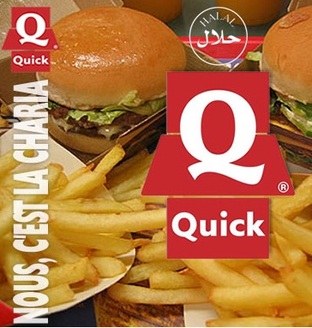 If you only hung out with hip hop heads in Paris, you would start to think that all French people share their food with the people around them. A bite for me, a bite for you, a bite for him, a bite for her. By the time it got back to you there'd only be a nickel-sized piece left. Luckily I've gotten over my inner-germaphobe and paranoia about contracting mono, having shared every can of soda, every piece of candy, and every buttery pastry offered me since I arrived. I've grown so accustomed to it that I've started to initiate the food cypher myself. As they say, "when in Paris…" So when I turned and offered a tasting of my Royale with Cheese to Sou, she shocked me with her refusal. "I can't eat it," she said. Judging by the half-eaten Filet O' Fish in front of her, I ruled out the possibility of her being veggie-tarian. "Waitaminute," furrowing my brow for dramatic effect, "are you Muslim??" (MickeyD's has yet to adopt a halal menu though French rival Quick has.)
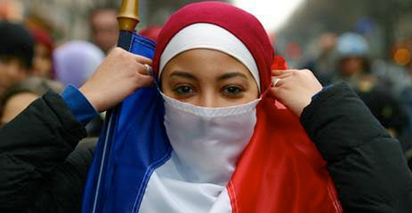 SOU
Sou and I have been friends for over a year and a half. She lived in New York City as an au pair for 6 months. We hung out countless times and not once did her religious faith ever come up. She revealed to me then that while in the states, she deliberately kept it secret; she worshipped Allah on the low. But why? Especially among friends?
Out of fear. "They don't like Muslims over there." Even though I doubt anyone would guess that this young Thai-Cambodian girl with the French accent was Muslim, she still felt the need to suppress her identity for self-protection. The US has produced so much fear of Muslims that it's spawned fear of Americans.
YOUSEF
Weeks later, I met Yousef who expressed to me his desire to one day visit New York. I encouraged him to. But in his broken English, he said that it's a bad idea because once he lands at JFK then…He brought his wrists behind his back to explain the word his vocabulary lacked--detained. He then pointed at his Arabic features, cited his name, and lamented, "It's not possible."
 ISLAMOPHOBIABut I thought it was France that leads the world in Islamophobia, at least against those within its own borders. It's France that bans burqas in public and denies citizenship to those who wear them as well as their husbands. It's France that wants to prohibit fast-food menus from conforming to halal restrictions under the guise of laicite or secularism. It's France that wants to revoke the citizenship of foreign-born French caught assaulting public servants. It's President Sarkozy who referred to the immigrant youth as racaille--a derogatory term meaning low-life scum--that he wants to be rid of. Message transmitted: You don't fit in here so go away.
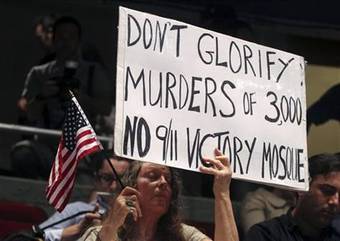 I suppose that's not quite at the level of no-fly lists, secret detentions, renditions, and waterboarding, but still, do people not regard the US as a place of religious freedom and melting pots and a president with Hussein in his name? I was even part of the fight that brought 49 of 51 New York City Council Members to vote for a resolution to adopt the major Muslim holidays as public school system-wide holidays (though the not so tolerant Mayor won't enact it). Then again, millions more know about the fight against the Muslim community center near Ground Zero.
The comparison is pointless. It's like a race to the bottom, finding the worst of two evils. A Muslim cabbie has his throat slashed in New York. A Muslim woman gets attacked while shopping in Paris. Intolerance and inequality know no boundaries. Yet, through shared adversity, strength and solidarity shine through the bigotry. In working class neighborhoods of New York, a certain degree of acrimony simmers amongst African Americans and Arabic immigrants that run local corner stores. Meanwhile in working class banlieues surrounding Paris, African and Arabic immigrants connect through a common religion, parallel cultures, and shared living conditions. Their youth blend into world champion dance crews, mighty rap groups, and all-star graffiti collectives. They find solace in each other as there's always strength in numbers. Afterall, France does have the largest Muslim population in Europe at 10% and totaling over 4.1 million. MOHAMEDMy friend Mohamed, a Moroccan-French beatmaker, learned that I'm of Filipino descent. His immediate follow up question, as his eyes widened in hopeful anticipation: Are you Muslim too?? I was sad to disappoint him. Unfortunately we can't connect on that level. In that moment, I kind of wish I had kept my faith (or lack thereof) a secret.
Fascinating survey data from our friends at the PewResearch Center in DC. Notice that there's a huge discrepancy between the greater French public that believes Muslims resist assimilation and French Muslims themselves who wish to adopt local customs. Also worth noting is the across-the-board agreement amongst European Muslims that the US is unfavorable.
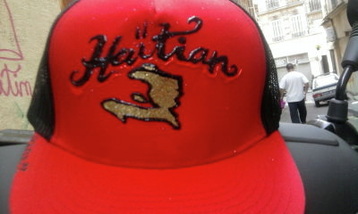 A guy I met makes custom ethnic apparel Fashion is undoubtedly one of the core elements of Hip Hop. After all, 1990's hip hoppers practically made the Tommy Hilfiger brand. And where would New Era fitteds be without Jay-Z? Hip Hop, in every one of its art forms, is all about stylistic expression. It's no surprise then that fashion, as an outward expression of style, is so embraced by the Hip Hop generation to connote culture and identity. It's about reppin' who you are and where you're from. The glocalized Hip Hop community here in Paris and France puts its own twist on that concept and the outfit trends from the US. Sure, the fitted caps, baggy pants, and fly sneakers remain a staple, but here young people spice up their wardrobes with a smattering of ethnic and religious roots.
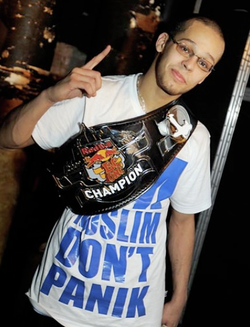 World b-boy champ Lilou At every event I attend, I always feel like I'm at a convening at the UN. In the middle of a cypher, there will be a gleaming turquoise jacket with "ALGERIE" embroidered across the chest. To the left, I'll spot the outline of the African continent colored in bright red, green and yellow, on the front of a sweatshirt. I'll pick out the word "SENEGAL" discreetly wrapped around a friend's wristband. And then of course, my favorite Tee yells out to me, with huge block letters, "I'm Muslim, Don't Panik!" As I observe, I notice that I too am rockin' my favorite Philippines revolution crew-neck.
Then there's the case of my friend Sam. I've seen him all of twice and both times he's worn the same t-shirt. Either that I always catch him around the same time as his laundry cycle, or he reserves this shirt specifically for Hip Hop gatherings. The shirt reads, "Algerien Pur Souche," basically "Pure Strain Algerian."
It's ironic because he's blonde-haired and blue-eyed. Being the nosy blogger that I am, I tried to pry the ethnicity out of him.
"What's your ethnic background?"
"Huh?" (His english is not that advanced)
"Where is your family from?"
"Algeria. I'm Algerian."
"But you don't look Algerian." (so insensitive, I know, sigh)
"My mother is French but she grew up in Algeria where she met my father."
"Ahaa!"
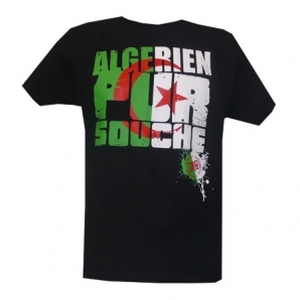 'Pure Strain Algerian' Sam, then, is not pure strain Algerian. But yet, his identity, regardless of genetics, most certainly is. The shirt proudly proclaims that identification, which is particularly useful in these settings that are predominately brown. Without the tee he might easily be relegated as an outsider. Instead, he wears it in defiance of his French heritage to resolutely say, "I am part of this culture, OUR culture." This need to assert ethnic and religious identity in these Hip Hop spaces is interesting because mainstream American Hip Hop can sometimes be so devoid of it. For example, the Caribbean heritage of icons such as DJ Kool Herc, Notorious BIG, and Busta Rhymes is not very well known. Neither is the Islamic faith of rappers such as Mos Def. In an America that's wrapped up with racial consciousness, these other forms of identities take a backseat to blackness. France, on the other hand, frames it's own issues around otherness along the lines of immigration and Islam. The sentiment then is not so much racist as it is xenophobic and islamophobic best represented by Sarkozy's most recent efforts. No wonder then that the Hip Hop heads in France resist by asserting ethnic and religious pride.
But true, not all drape themselves in flags and call it a day. Some are pushing boundaries or in fact re-drawing them. At Who Iz Underground, a guy walking around in his black letterman jacket would occasionally stop to chat up some friends. He'd open up his backpack and pull out some fresh white tees for them. He'd leave and they'd put them on immediately. Suddenly, a number of people had written all over them, "UNIVERSAL STREET." It didn't matter what country, ethnicity, or religion you came from; the culture and the experience is always the same. Street is Street. What's important is drowning out marginalization through unity and solidarity through the language of Hip Hop.
|

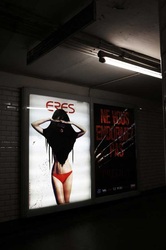
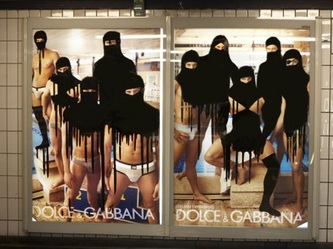
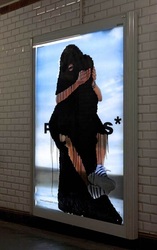
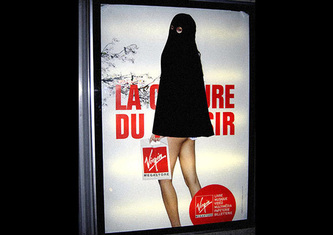





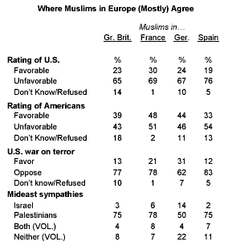
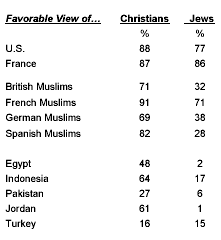


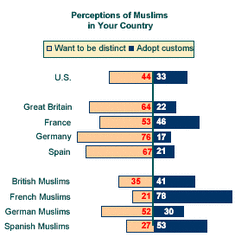



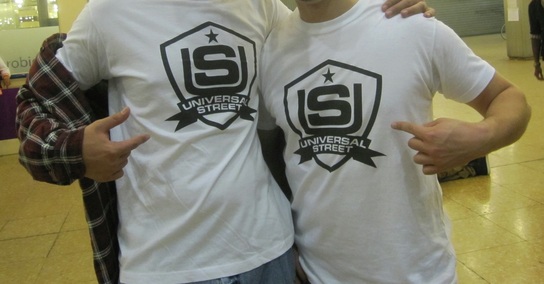
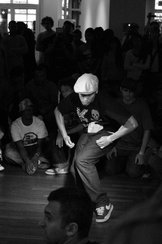
 RSS Feed
RSS Feed